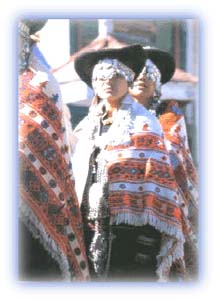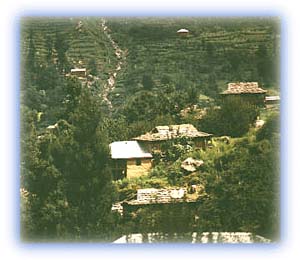Trekking
· General Info
· Prerequisites
· Trekking Methods
· Preparations
· Physical Conditioning
· Acclimatization
· High Altitude Sickness
· Food and Water
· Exchange of Currency
· Trekking Permits

![]()
| The Terrain The Himalayan ranges stretch from west to east for a distance of about 2500km running parallel to each other, having an average width of about 200 km. There are long chains of hills and mountains finally terminating in the Great Himalayan range which is covered with perpetual snow and merges with the high Tibetan plateau on the north. These mountain chains have been cut across by the great Himalayan rivers originating in the perpetual glaciers of the north and flowing southwards to ultimately merge into the Ganges, Brahmaputra and Indus river systems respectively in the plains of the Indian subcontinent. |
Himalayan Bridges. (Download Realplayer) |
Most of the trekking trails pass along these river valleys, while relatively fewer routes cross over high passes connecting one valley to another. In the Indian Himalayas, a large road net work has been constructed all along the major river valleys upto the remote corners which have reduced long approach marches. Here, smaller treks can be selected depending upto the time available. But many parts of the Nepal Himalayas still maintain virgin conditions with few accessible roads. These necessitate long treks involving 15 to 20 days, like the ones to the Everest Base Camp, Manang, Mukti Nath, Rara and Jumla.
 |
| Kinners during festivities. Credit: Discover India |
In large areas of the Indian Himalayas - be it the Shivaliks, or the Middle Himalayas - , the hills are inhabited by different types of people like the Rajputs, Kumaonese, Garhwalis, Kinners, Lahaulas, Gujjars and Ladakhis. People of Bhotia and Tibetan stock, like the Sherpas, also inhabit the northern region of the Himalayas, bordering Tibet. Therefore, it is important to understand the hill people. There is lots of cultural, architectural and social variations in each valley of the Himalayas.
In the eastern Himalayas the vegetation is predominantly dense bamboo jungle; village homes are built of bamboo and are spread around tracts of tilled land. In these areas of Assam, Sikkim and Bhutan, the Nepali influence dominates. On the other hand, in western Nepal, Garhwal and Kumaon, the climate is temperate with forests of pine and deodar. Here the houses are built of wood and slate in compact villages. Still further west the climate is more frigid , the landscape dry and barren and there is very little vegetation. As a result, the houses are built of stones and wood with flat roofs. In this areas, the Tibetan and Ladakhi influence dominates.
 |
| Credit: unknown |
With the development of road network in the sixties and seventies, the old trekking trails in the Indian Himalayas have been overshadowed. Earlier, small settlements along the route called Chattis would spring up which would accommodate the pilgrims. But the building of the road network, and with it the coming of the buses that pass these villages and directly move towards the destinations, have left these Chattis in poor shape. The old pilgrim trails and trekking infrastructure like the old Chattis and Dharamshala should be looked after in the Indian Himalayas with government assistance.
Today, various governmental infrastructural bases in the Indian Himalayas have been set up like the Kumaon and Garhwal Mandal Vikas Nigams, Himachal Tourism, Jammu and Kashmir and Ladakh tourism development departments. These, along with the various private trekking agencies have created facilities to organize treks in the region. As a result, tourism in the Himalayas is gradually picking up and becoming popular with Westerners who were, till recently, aware of trekking facilities in only a few places like Ladakh (India) and Nepal. Recently Nepal has developed good trekking tourism and the trails have been developed having small tea shops, hotels on the trail which can provide food and shelters at a regular distance.
All rights reserved